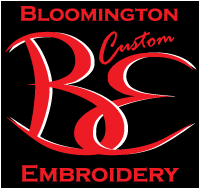
| Digitizing & Vectorizing |
| Digitizing $35 to $150 Vectorizing $25 to $35 (Most Designs) |
| Quality Embroidery and Screen Printing Since 1995 |
| This page will help explain how the whole process of Digitzing and Vectorizing works. The better the Artwork the better the design/logo with generally turn out. We do not require your artwork to be Vectorized for Embroidery but for Screen-Printed item's it is almost always a requirement especially when your design has multiply colors. If you plan on ever printing a sign or letter head in the future then you would want to have your logo Vectorized anyway. Most likely the person that created your design or logo already has it in a Vectorized format. Logo files with EPS or AI file extensions are most likely already Vectorized. Special software is required to open these files. |
| Embroidery digitizing it the process of converting artwork into a stitch file. How do we go about embroidery digitizing? The digitizer must first analyze the artwork to see if it should be edited for embroidery. We have to understand that not all logos and designs will work for embroidery. There are those that need to be simplified and correctly sized up. There may also be elements in the artwork that will be eliminated, and there will be some that will be altered, like enlarging small text and eliminating outlining. After finishing up on the modifications on the artwork in the program or software, the digitizer will then edit the design, from start to finish. This is an important process because if the design is not embroidered in the correct sequence, there may be unwanted gaps and uneven text. This process is also a factor on how long the design will be running on the machine during embroidery process. A smoother design made in a shorter time costs less. The digitizer then assigns stitch types to sections of the design. These will be based on what stitches will best bring out the beauty of the artwork. The underlay stitches will be added first. The underlay stitches should be done correctly because it helps the other remaining stitches have a smooth surface to embroider on. It also adds density to the design. When not done correctly, the stitches will sink into the fabric or allow the shirt fabric to show through the design. There are only three basic stitch types. These are run, satin, and fill stitches. There are many variations of these stitch types, however. The digitizer will have to decide what variation of the stitch to use, along with the direction of the stitch, where it should start and where it should stop. The digitizer also has to consider the type of fabric that the design will be embroidered on and make more adjustments. There are types or fabrics that may only ruin the design. A logo made for denim, for instance, does not look good when embroidered on fabrics where the stitches tend to sink into the fabric. There is also what we call the "push and pull" in embroidery digitizing. While being embroidered, a design may move and may cause some of the stitches to shift. This happens when using bulky and rough fabrics, long stitches, large areas of thread and a tight bobbin thread. A digitizer also has to consider the 'push and pull' effects and make the necessary adjustments. Designs with fine detail, small text, and lots of colors obviously needs more set-up time for the digitizer. Time and experience is essential to digitizing, since there are a lot of stitches, fabrics, and factors to consider in the art of embroidery digitizing. |
| Vectorizing It is the art of converting raster images to line art images format. Line art images are size independent. That means it can be scaled up and down without losing any quality. The image will be of same quality no matter what size it is being scaled. To explain it better is to represent a graphic image, with each bit or group of bits corresponding to a pixel in the image. When Bitmap image is enlarged, it produces jagged edge and graininess, which is not print friendly. The bitmap file is comprised of a series of dots per inch (dpi) and when you enlarge a bitmap, rather than more dots being added, the existing dots are simply enlarged. The larger the dots get, the blurrier the image will be. Examples of Bitmap images are JPG, TIF, BMP and GIF. usually created with the drawing program such as CorelDraw, Adobe Illustrator or Freehand. Increase or reduction in size will produce no pixelization . The combination of one of these programs with an expert digital artist can create a beautiful artwork that can be used on print articles. |
| © 2017 WWW.4ALARMCLOTHING.COM ALL RIGHTS RESERVED |
| 952-844-0799 |